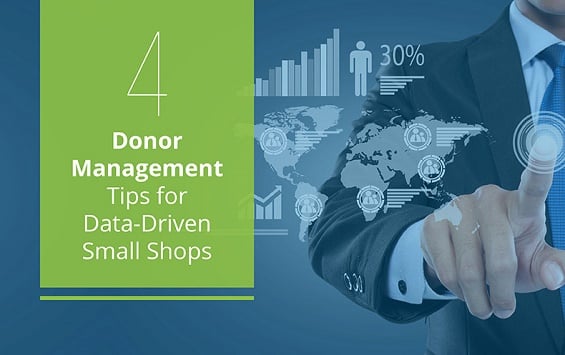4 Donor Management Tips for Data-Driven Small Shops

In the nonprofit world, it can be tough to be a small shop. With fewer resources and a smaller constituency than many of your larger counterparts, it’s difficult to keep a hold of the donors you do have while growing your base at the same time.
But that doesn’t mean your organization can’t achieve both of these things. In fact, through excellent donor management, you can stand head-to-head with larger nonprofits while still keeping your small shop spirit.
The best way to master donor management? Data-driven donor relations. Check out these 4 simple tips to better manage your donors through expert donor data analysis:
- Make the most of your CRM.
- Refresh your donor data.
- Learn from your data.
- Know what data you need.
Ready to learn more about what it takes to perfect donor management as a small shop? Let’s get started!

1. Make the most of your CRM.
For nonprofits, large or small, the foundation of great donor management is a solid CRM.
Nonprofit CRM software, or constituent relationship management software, helps you keep track of your supporters by collecting data on them as you interact. A comprehensive CRM can help you strategize donor engagement in a way that wouldn’t be possible without streamlining your volunteer and donor data.
Because nonprofits are often limited in terms of financial resources, it can be tempting to write off CRM software as an unnecessary expense. And yes, some CRM options on the market are quite pricey. However, there are many low-cost CRMs out there, including several free options!
Some nonprofits try to get around adopting a dedicated CRM by keeping all of their donor data in spreadsheets or other files. Unfortunately, this can lead to disorganized data that are difficult to access and impossible to view as a cohesive picture of the state of your donor community.
Luckily, CRMs offer several features that can simplify understanding your donor data:
- Donor profiles. In your donor profiles, you can keep track of a donor’s contact information, donation history, demographic information, and more. You can analyze donor profiles against one another to better strategize donor engagement, and you can use the information found in profiles to help promote recurring donations.
- Engagement tracking. Engagement tracking features help you oversee how constituents respond to certain fundraisers and outreach strategies. If you want to be able to look back on your nonprofit’s experiences to see which techniques work and which don’t, you need to be tracking engagement through your CRM.
- Donation processing. Many CRMs can help you process donations. This may be through an integrated payment processing feature or other donation management tools. By integrating donation processing with your CRM, you gain the bonus of collecting payment-related donation data to revisit in the future.
- Software integration. Many CRMs integrate with other fundraising software, and volunteer management tools which allow you to collect even more information on your constituency that can be put to use to grow your donor base.
Takeaway: Without dedicated features like these, it’s nearly impossible to stay on top of your donors with the same level of accuracy. By collecting constituent data as you go, your CRM will help you better engage with your donors and better strategize fundraising efforts in the future.

2. Refresh your donor and volunteer data.
One common mistake small nonprofits often make is not returning to the constituency data they’ve collected to periodically refresh it. What results are donor and volunteer databases filled with outdated, incorrect, or duplicated information that cannot be used to help manage or grow donor communities?
Even if you don’t have a CRM yet, it’s integral to continue to revisit your existing donor data because it can help you see where there are gaps in your donor outreach strategy.
Here are a few common problems that result from not revisiting and cleaning your donor database often enough:
- Database bloat. Often, inactive donor profiles remain unnoticed in donor databases, which artificially inflates the size of your constituency. You can consider donors inactive if they haven’t donated to your organization in over two years. Remove these donors from your active donors roster, but keep their information on file for later outreach.
- Duplicate donors. It’s also common to accidentally collect duplicate information on the same donor and treat each set of data as if it were attributed to a unique individual. A CRM can help you identify duplicate data and consolidate donor information into a single profile.
- Incorrect data. Perhaps the largest problem faced by nonprofits is the unintentional cultivation of incorrect donor data. You may have logged incorrect contact information or donation history for a donor, and without revisiting that data to ensure that it’s correct, you won’t know that that particular dataset isn’t helping you grow your community.
Takeaway: By occasionally revisiting your donor database, you can get a better idea of where you need to improve as an organization. If you’ve adopted a CRM, revisiting donor data is made even more simple, and it’s easier to verify donor data as you collect it.

3. Learn from your data.
Now that you’ve adopted a CRM and refreshed your donor data, it’s time to put everything you’ve collected about donors to good use. Based on this data, what can you learn about how to better serve your constituency?
To get started on your self-evaluation, there are a few key questions to ask.
Are you fundraising efficiently?
Do you participate in crowdfunding? Peer-to-peer fundraising? Do you hold in-person events, like auctions or walkathons? Certain constituencies are better suited for different styles of fundraising events.
For example, if your data shows that your active donors donate more frequently when you hold a peer-to-peer campaign, you might decide to focus your efforts on online fundraising events rather than on in-person fundraising events.
If your current fundraising efforts are floundering, it might be time to look at your constituent data and think of fundraising ideas that are a better fit for your constituency.
What communication platforms work best for your donors?
Similarly, certain modes of communication are better suited for both your constituents and your organization alike, and you need to look toward your donor data to figure out which forms you should prioritize.
If you find that your donors are more aware of upcoming fundraising events when they’re heavily promoted on your Facebook page, you might decide to put more effort into social media outreach.
In addition, if you find that donors are ignoring your emails or marking them as spam, you may consider adjusting the way you communicate with donors through email.
Use engagement data to inform how you should strategize donor interaction in the future, and shape your communication techniques to the demographics and preferences of your constituency.
What is the demographic makeup of your donors?
Some of the most important datasets you can analyze will inform you about the demographics of your donor base.
As much as you can, collect data on donors such as age, gender, income level, occupation, and more. You can always keep the disclosure of various demographic identifiers voluntary, but it might help you improve your strategy to know these things.
Demographic information will complement your understanding of nearly all donor interactions, so be sure it make analyzing it a priority.
Takeaway: Analyze your donor data and make conclusions based on what you learn about your constituency. The more informed you are about the state of your donor community, the better you’ll be able to manage them efficiently.

4. Know what data you need.
Finally, the best possible thing you can do to better manage your donor data is to think forward. How do you want your donor data to look as your nonprofit grows?
After analyzing your current data, identify the gaps in donor information you see and use that as a jumping-off point to figure out what donor data you should try to collect moving forward.
What are your small shop’s long-term goals?
It’s easy to get caught up in the day-to-day realities of running your organization and to lose sight of the bigger picture. Take a moment to think of what you’d like to see your nonprofit do when armed with the best possible donor data.
Some long-term goals to prioritize may be:
- Encouraging recurring donation
- Improving donor relations
- Adding efficiency to fundraising event logistics
If you’ve been held back by disorganized constituency information in the past, this is your chance to accomplish your most ambitious goals yet.
What more do you need to learn about donors to make your goals a reality, and what data points will prove necessary to help you achieve those goals?
How do you want to see your constituency evolve?
In the past, you might not have been able to efficiently analyze the makeup of your donor community. Now that you know more about your constituency, think of the ways you’d like to see it evolve.
This might mean you’d like to see your constituency grow in size, that you’d like to see the median income of your donor community increase or any number of things.
For example, if you see that the majority of your constituents are from middle-income households and you’d like to increase the number of upper-middle-class earners in your constituency, use your data to revamp your donor outreach strategy.
Do I need help managing my constituency?
As a small shop, you already know that you have access to fewer resources than your larger counterparts. Since you’ve gotten a better understanding of your constituency by overhauling the way you manage donor data, you may have found that there are aspects of running a nonprofit that you aren’t handling efficiently, or that you aren’t equipped to manage on your own.
Consider hiring a fundraising consultant to help guide you through this next stage of your organization.
As you look forward, it always helps to have an outsider’s perspective of what you should be doing to better manage your donor community in the future, and there’s no one better than a dedicated, professional fundraising consultant.
Takeaway: There’s always room to improve your donor management, and you will always find knowledge gaps that need to be filled through data collection. Set goals for what you’d like to accomplish with donors, and for how you’d like to see your constituency grow. When necessary, don’t be afraid to reach out to a consultant for help with your donor management needs.
As a small nonprofit, you might sometimes feel that you’re a little fish in the big pond that is the nonprofit sector. But that just means your constituency has room to grow!
Now that you’ve learned how to better manage volunteers and your donor community, there’s no limit to how far your organization can go.
Author Bio
 John Killoran is CEO of @Pay, an exciting new fundraising technology that makes it easy for people to donate in two clicks from text, email, web, and social media sites. John pioneered SMTP payments and has been a major innovator in the mobile payments space for the past 5 years. When he is not running a company, he is cooking food for his family and telling his dogs to stop barking.
John Killoran is CEO of @Pay, an exciting new fundraising technology that makes it easy for people to donate in two clicks from text, email, web, and social media sites. John pioneered SMTP payments and has been a major innovator in the mobile payments space for the past 5 years. When he is not running a company, he is cooking food for his family and telling his dogs to stop barking.




